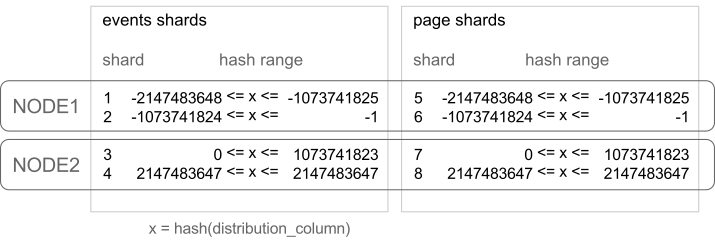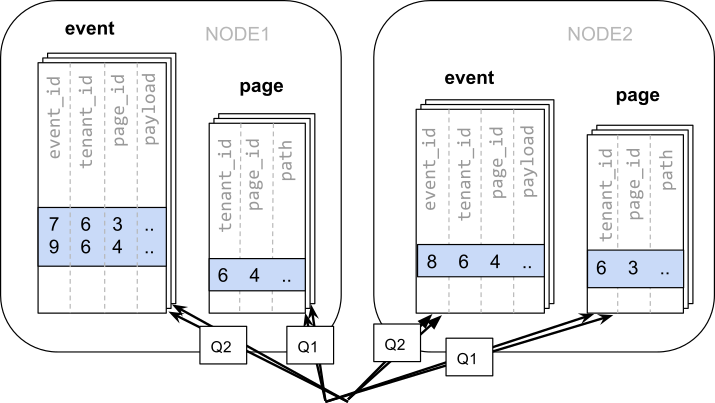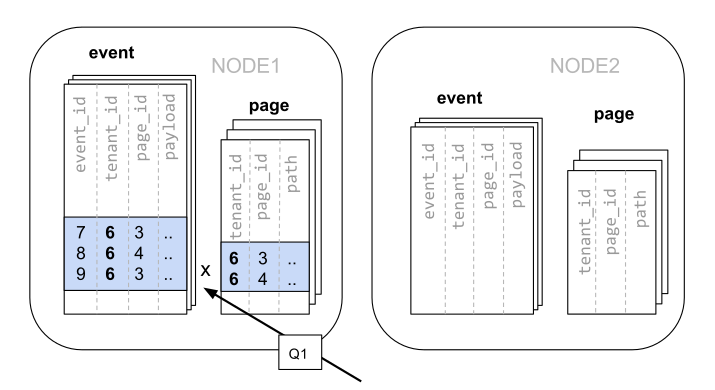Table Co-Location¶
Relational databases are the first choice of data store for many applications due to their enormous flexibility and reliability. Historically the one criticism of relational databases is that they can run on only a single machine, which creates inherent limitations when data storage needs outpace server improvements. The solution to rapidly scaling databases is to distribute them, but this creates a performance problem of its own: relational operations such as joins then need to cross the network boundary. Co-location is the practice of dividing data tactically, where one keeps related information on the same machines to enable efficient relational operations, but takes advantage of the horizontal scalability for the whole dataset.
The principle of data co-location is that all tables in the database have a common distribution column and are sharded across machines in the same way, such that rows with the same distribution column value are always on the same machine, even across different tables. As long as the distribution column provides a meaningful grouping of data, relational operations can be performed within the groups.
Data co-location in Citus for hash-distributed tables¶
The Citus extension for PostgreSQL is unique in being able to form a distributed database of databases. Every node in a Citus cluster is a fully functional PostgreSQL database and Citus adds the experience of a single homogenous database on top. While it does not provide the full functionality of PostgreSQL in a distributed way, in many cases it can take full advantage of features offered by PostgreSQL on a single machine through co-location, including full SQL support, transactions and foreign keys.
In Citus a row is stored in a shard if the hash of the value in the distribution column falls within the shard’s hash range. To ensure co-location, shards with the same hash range are always placed on the same node even after rebalance operations, such that equal distribution column values are always on the same node across tables.

A distribution column that we’ve found to work well in practice is tenant ID in multi-tenant applications. For example, SaaS applications typically have many tenants, but every query they make is specific to a particular tenant. While one option is providing a database or schema for every tenant, it is often costly and impractical as there can be many operations that span across users (data loading, migrations, aggregations, analytics, schema changes, backups, etc). That becomes harder to manage as the number of tenants grows.
A practical example of co-location¶
Consider the following tables which might be part of a multi-tenant web analytics SaaS:
CREATE TABLE event (
event_id bigint,
tenant_id int,
page_id int,
payload jsonb,
primary key (tenant_id, event_id)
);
CREATE TABLE page (
page_id int,
tenant_id int,
path text,
primary key (tenant_id, page_id)
);
Now we want to answer queries that may be issued by a customer-facing dashboard, such as: “Return the number of visits in the past week for all pages starting with ‘/blog’ in tenant six.”
Using Regular PostgreSQL Tables¶
If our data was in a single PostgreSQL node, we could easily express our query using the rich set of relational operations offered by SQL:
SELECT page_id, count(event_id)
FROM
page
LEFT JOIN (
SELECT * FROM event
WHERE (payload->>'time')::timestamptz >= now() - interval '1 week'
) recent
USING (tenant_id, page_id)
WHERE tenant_id = 6 AND path LIKE '/blog%'
GROUP BY page_id;
As long the working set for this query fits in memory, this is an appropriate solution for many application since it offers maximum flexibility. However, even if you don’t need to scale yet, it can be useful to consider the implications of scaling out on your data model.
Distributing tables by ID¶
As the number of tenants and the data stored for each tenant grows, query times will typically go up as the working set no longer fits in memory or CPU becomes a bottleneck. In this case, we can shard the data across many nodes using Citus. The first and most important choice we need to make when sharding is the distribution column. Let’s start with a naive choice of using event_id for the event table and page_id for the page table:
-- naively use event_id and page_id as distribution columns
SELECT create_distributed_table('event', 'event_id');
SELECT create_distributed_table('page', 'page_id');
Given that the data is dispersed across different workers, we cannot simply perform a join as we would on a single PostgreSQL node. Instead, we will need to issue two queries:
Across all shards of the page table (Q1):
SELECT page_id FROM page WHERE path LIKE '/blog%' AND tenant_id = 6;
Across all shards of the event table (Q2):
SELECT page_id, count(*) AS count
FROM event
WHERE page_id IN (ARRAY[...page IDs from first query...]) AND
tenant_id = 6 AND
payload->>'time' >= now() - interval '1 week'
GROUP BY page_id ORDER BY count DESC LIMIT 10;
Afterwards, the results from the two steps need to be combined by the application.
The data required to answer the query is scattered across the shards on the different nodes and each of those shards will need to be queried:

In this case the data distribution creates substantial drawbacks:
- Overhead from querying each shard, running multiple queries
- Overhead of Q1 returning many rows to the client
- Q2 becoming very large
- The need to write queries in multiple steps, combine results, requires changes in the application
A potential upside of the relevant data being dispersed is that the queries can be parallelised, which Citus will do. However, this is only beneficial if the amount of work that the query does is substantially greater than the overhead of querying many shards. It’s generally better to avoid doing such heavy lifting directly from the application, for example by pre-aggregating the data.
Distributing tables by tenant¶
Looking at our query again, we can see that all the rows that the query needs have one dimension in common: tenant_id. The dashboard will only ever query for a tenant’s own data. That means that if data for the same tenant are always co-located on a single PostgreSQL node, our original query could be answered in a single step by that node by performing a join on tenant_id and page_id.
In Citus, rows with the same distribution column value are guaranteed to be on the same node. Each shard in a distributed table effectively has a set of co-located shards from other distributed tables that contain the same distribution column values (data for the same tenant). Starting over, we can create our tables with tenant_id as the distribution column.
-- co-locate tables by using a common distribution column
SELECT create_distributed_table('event', 'tenant_id');
SELECT create_distributed_table('page', 'tenant_id', colocate_with => 'event');
In this case, Citus can answer the same query that you would run on a single PostgreSQL node without modification (Q1):
SELECT page_id, count(event_id)
FROM
page
LEFT JOIN (
SELECT * FROM event
WHERE (payload->>'time')::timestamptz >= now() - interval '1 week'
) recent
USING (tenant_id, page_id)
WHERE tenant_id = 6 AND path LIKE '/blog%'
GROUP BY page_id;
Because of the tenantid filter and join on tenantid, Citus knows that the entire query can be answered using the set of co-located shards that contain the data for that particular tenant, and the PostgreSQL node can answer the query in a single step, which enables full SQL support.

In some cases, queries and table schemas will require minor modifications to ensure that the tenant_id is always included in unique constraints and join conditions. However, this is usually a straightforward change, and the extensive rewrite that would be required without having co-location is avoided.
While the example above queries just one node because there is a specific tenant_id = 6 filter, co-location also allows us to efficiently perform distributed joins on tenant_id across all nodes, be it with SQL limitations.
Co-location means better feature support¶
The full list of Citus features that are unlocked by co-location are:
- Full SQL support for queries on a single set of co-located shards
- Multi-statement transaction support for modifications on a single set of co-located shards
- Aggregation through INSERT..SELECT
- Foreign keys
- Distributed outer joins
Data co-location is a powerful technique for providing both horizontal scale and supporting relational data models. The cost of migrating or building applications using a distributed database that enables relational operations through co-location is often substantially lower than moving to a restrictive data model (e.g. NoSQL) and unlike a single-node database it can scale out with the size of your business. For more information about migrating an existing database see Transitioning to a Multi-Tenant Data Model.

